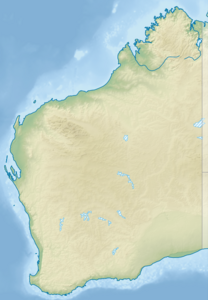Laceped Islands
| Laceped Islands | ||
|---|---|---|
| Satellite image | ||
| Waters | Timor Sea | |
| Geographical location | 16 ° 53 ′ S , 122 ° 10 ′ E | |
|
|
||
| Number of islands | 4th | |
| Main island | West Iceland | |
| Total land area | 1.65 km² | |
| Residents | uninhabited | |
The Laceped Islands are a chain of islands consisting of four small islands off the northwest coast of Australia (150 km north of Broome in Western Australia ). The islands are now a nature reserve.
geography
With East Island, the archipelago is a good 20 kilometers off the coast of the Dampier Peninsula and is separated from it by the Lacepede Channel . It stretches over 12 kilometers from southeast to northwest. The total area of the islands is 165 hectares . Other sources give 180.2 and 162.9 hectares, respectively.
The individual islands are:
- East Island (3.5 ha)
- Sandy Island (7.94 hectares)
- Middle Island (60.9 ha)
- West Iceland (90.6 ha)
East Iceland is but the smallest of the four islands has a lighthouse East Iceland Lighthouse on which secures the Lacepede Channel.
Administratively, the archipelago, like most of the Dampier Peninsula, belongs to the Broome Shire .
history
The islands, consisting of sand and coral debris on a coral reef , were discovered in 1801 by the French explorer Nicolas Baudin and named after the French naturalist Bernard Germain Lacépède , whose son accompanied the expedition as a naturalist.
Wildlife
The West and Middle Islands are home to one of the largest breeding colonies of brown gannets ( Sula leucogaster ) and ariel frigate birds ( Fregata ariel ) in the Indian Ocean . On the West Island there is another bay, Lagoon Creek, with an extensive mudflat that attracts migratory waders and terns .
Bird species living here are:
- Chinstrap tern ( Sterna anaethetus )
- Noddise Tern ( Anous stolidus )
- Rüppellseeschwalbe ( Sterna bengalensis )
- Rose tern ( Sterna dougallii )
- Predatory tern ( Sterna caspia )
- Little tern ( Sterna albifrons )
- Pelicans
- Magpie ( Phalacrocorax varius )
The mating season of the green turtle ( Chelonia mydas ) begins in October in the waters around the West Island. When the wet season begins, the females lay their eggs. The largest West Australian colony of green turtles lives on the islands.
In smaller numbers there are also clutches of the barrier reef turtle ( Natator depressus ) on the islands.
The many seabirds left behind large amounts of guano that were exploited by Americans between 1850 and 1870 . The USA also made claims (probably according to the Guano Islands Act ) on the islands themselves, but these were dropped after a complaint by the West Australian government.
Individual evidence
- ^ Birdlife Data Zone: Lacepede Islands
- ↑ version_14april2010.pdf # page = 23 CONSERVATION COMMISSION OF WESTERN AUSTRALIA: STATUS PERFORMANCE ASSESSMENT: BIODIVERSITY CONSERVATION ON WESTERN AUSTRALIAN ISLANDS. PHASE II - KIMBERLEY ISLANDS. FINAL REPORT ( page no longer available , search in web archives ) Info: The link was automatically marked as defective. Please check the link according to the instructions and then remove this notice. , P. 21

